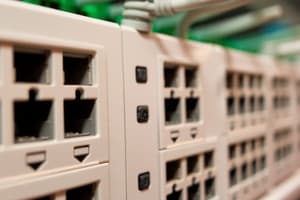Podcast
Questions and Answers
What command can be used on a Cisco router to display the ARP table?
What command can be used on a Cisco router to display the ARP table?
- display arp table
- view ip arp entries
- show arp cache
- show ip arp (correct)
Which command in Windows displays ARP information?
Which command in Windows displays ARP information?
- arp -a (correct)
- netstat -arp
- show arp
- ipconfig /arp
What can excessive ARP broadcasts cause in a network?
What can excessive ARP broadcasts cause in a network?
- Decreased network congestion
- Improved network performance
- Network congestion (correct)
- Increased bandwidth usage
Which of the following is a potential vulnerability related to ARP?
Which of the following is a potential vulnerability related to ARP?
What is typically a method to mitigate ARP attacks in enterprise-level switches?
What is typically a method to mitigate ARP attacks in enterprise-level switches?
What is ARP spoofing primarily used for by threat actors?
What is ARP spoofing primarily used for by threat actors?
Which devices are capable of sending and processing ARP requests?
Which devices are capable of sending and processing ARP requests?
How can ARP entries be removed from the cache?
How can ARP entries be removed from the cache?
What is the main purpose of the Address Resolution Protocol (ARP) in IPv4?
What is the main purpose of the Address Resolution Protocol (ARP) in IPv4?
Which of the following correctly describes the roles of MAC and IP addresses?
Which of the following correctly describes the roles of MAC and IP addresses?
In IPv6, what is the role of ICMPv6?
In IPv6, what is the role of ICMPv6?
What happens if the destination IP address is on the same network?
What happens if the destination IP address is on the same network?
What type of address do MAC addresses represent?
What type of address do MAC addresses represent?
Which statement is true regarding communication across multiple networks?
Which statement is true regarding communication across multiple networks?
When the destination IP address points to a remote network, which MAC address is used?
When the destination IP address points to a remote network, which MAC address is used?
What is the significance of understanding the difference between MAC and IP addresses?
What is the significance of understanding the difference between MAC and IP addresses?
What is the primary function of ICMPv6 neighbor advertisement messages in relation to IP addresses?
What is the primary function of ICMPv6 neighbor advertisement messages in relation to IP addresses?
How does a device determine the MAC address of a local device when the destination IP is known in IPv4?
How does a device determine the MAC address of a local device when the destination IP is known in IPv4?
What does the ARP cache timer do in relation to the ARP table?
What does the ARP cache timer do in relation to the ARP table?
What differentiates the destination MAC address when the destination IP is on a remote network?
What differentiates the destination MAC address when the destination IP is on a remote network?
Which of the following best describes how IPv6 differs from IPv4 with regard to address resolution?
Which of the following best describes how IPv6 differs from IPv4 with regard to address resolution?
What is the role of Ethernet MAC addresses in data transmission?
What is the role of Ethernet MAC addresses in data transmission?
What is the main function of the ARP protocol in IPv4 networks?
What is the main function of the ARP protocol in IPv4 networks?
Which aspect of IPv4 does NOT apply to IPv6 in terms of neighbor discovery?
Which aspect of IPv4 does NOT apply to IPv6 in terms of neighbor discovery?
What is the primary function of an ARP table in relation to IPv4 addresses?
What is the primary function of an ARP table in relation to IPv4 addresses?
When will a device search for the IP address of the default gateway in its ARP table?
When will a device search for the IP address of the default gateway in its ARP table?
What does the device utilize to determine the destination MAC address using an IPv4 address?
What does the device utilize to determine the destination MAC address using an IPv4 address?
Which process in IPv6 replaces the function of ARP used in IPv4?
Which process in IPv6 replaces the function of ARP used in IPv4?
What happens if a device can't find the destination IPv4 address in its ARP table?
What happens if a device can't find the destination IPv4 address in its ARP table?
What does 'mapping' in the context of ARP imply?
What does 'mapping' in the context of ARP imply?
Which of the following correctly describes the ARP table structure?
Which of the following correctly describes the ARP table structure?
In what scenario would a device consult its ARP table for an IPv4 address?
In what scenario would a device consult its ARP table for an IPv4 address?
What is the purpose of sending an ARP request if no entry is found in the ARP table?
What is the purpose of sending an ARP request if no entry is found in the ARP table?
How does an ARP request relate to the ARP table?
How does an ARP request relate to the ARP table?
What happens to entries in the ARP table over time?
What happens to entries in the ARP table over time?
What is the primary function of ICMP v6 neighbor solicitation messages?
What is the primary function of ICMP v6 neighbor solicitation messages?
What does the ARP table cache timer do?
What does the ARP table cache timer do?
Which messages are used for router discovery in IPv6 Neighbor Discovery?
Which messages are used for router discovery in IPv6 Neighbor Discovery?
Which factor differentiates the ARP table cache timer between devices?
Which factor differentiates the ARP table cache timer between devices?
What type of addresses are used in ICMP v6 neighbor solicitation messages?
What type of addresses are used in ICMP v6 neighbor solicitation messages?
Where can students find a video that explains ARP requests in more detail?
Where can students find a video that explains ARP requests in more detail?
In what scenario would an IPv6 device use a neighbor advertisement message?
In what scenario would an IPv6 device use a neighbor advertisement message?
What should students do if they don’t have access to Cisco NetAcad?
What should students do if they don’t have access to Cisco NetAcad?
What does the neighbor discovery protocol not provide?
What does the neighbor discovery protocol not provide?
Which of the following statements about the ARP operation is correct?
Which of the following statements about the ARP operation is correct?
Which of the following best describes the relationship between NS and NA messages?
Which of the following best describes the relationship between NS and NA messages?
What role does ICMP v6 play in IPv6 Neighbor Discovery?
What role does ICMP v6 play in IPv6 Neighbor Discovery?
How does an IPv6 device respond to a neighbor solicitation request?
How does an IPv6 device respond to a neighbor solicitation request?
Flashcards
MAC Address
MAC Address
The unique physical address assigned to a network interface card (NIC). Used for communication between devices on the same Ethernet network.
IP Address
IP Address
The logical address used to identify devices on a network. Can be used for communication across multiple networks.
ARP (Address Resolution Protocol)
ARP (Address Resolution Protocol)
A protocol used by IPv4 to associate an IP address with a MAC address on a device. This helps devices on the same network find each other.
Neighbor Discovery (ND)
Neighbor Discovery (ND)
A protocol used by IPv6 to associate an IPv6 address with a MAC address on a device. Similar to ARP, but for IPv6.
Signup and view all the flashcards
Default Gateway
Default Gateway
A device that acts as a gateway between a local network and other networks. It forwards packets to other networks based on their destination IP addresses.
Signup and view all the flashcards
Address Resolution
Address Resolution
The process of translating between IP addresses and MAC addresses. It is used to determine the MAC address of a device based on its known IP address.
Signup and view all the flashcards
Remote Network
Remote Network
Used to send packets to a remote network. The destination MAC address is the MAC address of the default gateway.
Signup and view all the flashcards
Local Network
Local Network
The address of a device on a local network. The destination MAC address is the MAC address of the destination device.
Signup and view all the flashcards
ARP Table
ARP Table
A table maintained by ARP that maps IPv4 addresses to their corresponding MAC addresses.
Signup and view all the flashcards
ARP Resolution
ARP Resolution
The process of resolving an IPv4 address to a MAC address.
Signup and view all the flashcards
ARP and Default Gateway
ARP and Default Gateway
The default gateway's IPv4 address is used when the destination device is on a different network.
Signup and view all the flashcards
ARP and Destination Address
ARP and Destination Address
A network device will search its ARP table for the MAC address associated with the destination IPv4 address.
Signup and view all the flashcards
MAC Address Association in IPv6
MAC Address Association in IPv6
IPv6 uses ICMPv6 to associate MAC addresses with network interface cards.
Signup and view all the flashcards
ARP and Same Network
ARP and Same Network
The destination network is the same as the source network.
Signup and view all the flashcards
ARP and Different Network
ARP and Different Network
The destination network is different from the source network.
Signup and view all the flashcards
ARP Request
ARP Request
A process where a device sends out a broadcast message to discover the MAC address of a device with a specific IP address.
Signup and view all the flashcards
ARP Reply
ARP Reply
A response to an ARP request, containing the MAC address of the device with the requested IP address.
Signup and view all the flashcards
ARP Spoofing
ARP Spoofing
An attack where a malicious actor sends fake ARP replies to trick devices into thinking they are a legitimate device with a specific IP address.
Signup and view all the flashcards
ARP Broadcast Vulnerability
ARP Broadcast Vulnerability
A security vulnerability that exploits ARP's broadcast nature, potentially leading to network congestion as devices send and receive unnecessary broadcasts.
Signup and view all the flashcards
ARP Mitigation Techniques
ARP Mitigation Techniques
A technique used by enterprise-level switches to prevent ARP attacks by verifying ARP replies and blocking suspicious requests.
Signup and view all the flashcards
Neighbor Discovery
Neighbor Discovery
The process of finding the MAC address of a device in a network using the IPv6 protocol.
Signup and view all the flashcards
Neighbor Discovery Cache
Neighbor Discovery Cache
A table that stores the mapping of IPv6 addresses to MAC addresses in an IPv6 network.
Signup and view all the flashcards
Address Resolution Protocol (ARP)
Address Resolution Protocol (ARP)
A protocol used to map IPv4 addresses to MAC addresses, allowing devices on the same network to communicate.
Signup and view all the flashcards
ARP Cache Timer
ARP Cache Timer
A timer that removes entries from the ARP cache that have not been used for a specific period of time.
Signup and view all the flashcards
IPv6 and ARP
IPv6 and ARP
IPv6 does not use ARP to resolve addresses because it has a different mechanism called Neighbor Discovery.
Signup and view all the flashcards
ARP Operation
ARP Operation
The process of automatically updating the ARP table with the latest information about devices on the network.
Signup and view all the flashcards
Removing Entries from the ARP Table
Removing Entries from the ARP Table
The process of removing entries from the ARP table to ensure that outdated information is not used.
Signup and view all the flashcards
Updating the ARP Table
Updating the ARP Table
The process of updating the ARP table when a device's MAC address changes.
Signup and view all the flashcards
ARP Role in Network Communications
ARP Role in Network Communications
A mechanism that allows devices on a network to communicate with each other. It allows devices to send and receive data using their IP addresses, even if their MAC addresses are not known.
Signup and view all the flashcards
IPv6 Neighbor Discovery Protocol
IPv6 Neighbor Discovery Protocol
The IPv6 Neighbor Discovery protocol provides services including address resolution, router discovery, and redirection.
Signup and view all the flashcards
ICMPv6 Neighbor Solicitation (NS)
ICMPv6 Neighbor Solicitation (NS)
A special type of ICMPv6 message used to request the MAC address of a device with a known IPv6 address.
Signup and view all the flashcards
ICMPv6 Neighbor Advertisement (NA)
ICMPv6 Neighbor Advertisement (NA)
An ICMPv6 message sent in response to a Neighbor Solicitation, containing the MAC address of the device with the requested IPv6 address.
Signup and view all the flashcards
Router Discovery
Router Discovery
A method used by IPv6 devices to discover and communicate with routers on the network.
Signup and view all the flashcards
Redirection
Redirection
A process used by IPv6 devices to redirect traffic to a different router based on specific conditions, such as network congestion.
Signup and view all the flashcards
ICMPv6 Router Advertisement (RA)
ICMPv6 Router Advertisement (RA)
A type of ICMPv6 message used by routers to announce their presence and capabilities to other network devices.
Signup and view all the flashcards
ICMPv6 Router Solicitation (RS)
ICMPv6 Router Solicitation (RS)
A type of ICMPv6 message used by devices to find routers and learn about their capabilities.
Signup and view all the flashcardsStudy Notes
IPv4 and IPv6 Address Resolution
- Address Resolution Protocol (ARP) maps IPv4 addresses to Media Access Control (MAC) addresses
- Neighbor Discovery Protocol (NDP) maps IPv6 addresses to MAC addresses
- Layer 2 (MAC) addresses used for communication between network interface cards (NICs) on the same local area network (LAN)
- Layer 3 (IP) addresses used for communication across different networks
- If destination IP is on the same network, the destination MAC address is the destination device's MAC address
- If destination IP is on a remote network, the destination MAC address is the default gateway's MAC address
ARP Operation
- Device searches its ARP table for the destination IPv4 address
- If found, the corresponding MAC address is used as the destination MAC address
- If not found, the device sends an ARP request
- The request, used to update ARP table, allows devices to associate IP addresses with device MAC addresses
- ARP request received by destination device
- Device responds with its MAC address in an ARP reply
IPv6 Neighbor Discovery
- Used for address resolution in IPv6 networks
- Uses ICMPv6 messages (neighbor solicitation and neighbor advertisement) for address resolution
- Devices in IPv6 networks use NDP to discover MAC addresses associated with known IPv6 addresses
- Neighbor Solicitation is used to resolve IPv6 addresses to a MAC address, while also discovering available routers on a network
- Neighbor Advertisement is used to provide the ICMPv6 reply to the Neighbor Solicitation
- Device receives the neighbor advertisement message and updates its table with the corresponding MAC Address
ARP Table Management
- Entries in the ARP table are not permanent and are removed after a specific or random time period
- Cisco devices use a timer to remove entries from the ARP table
- Administrators can manually remove entries from the ARP table
Using Show Commands
- Use
show ip arpcommand on Cisco devices to display the ARP table - Use
arp -acommand on Windows devices to display the ARP table
Studying That Suits You
Use AI to generate personalized quizzes and flashcards to suit your learning preferences.




